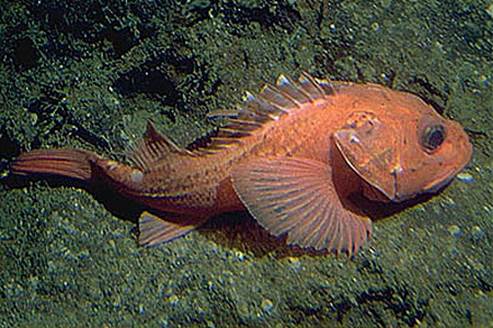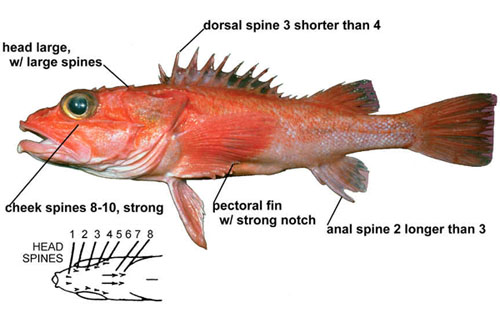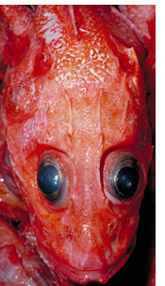Fish heads, fish heads, roly-poly fish heads,Fish heads, fish heads, eat them up yum!In the morning laughing happy fish headsIn the evening floating in the soup,Ask a fish head anything you want toThey won’t answer, they can’t talk – Fish head song, Barnes and Barnes
his is a small rockfish with a wide range, inhabiting the Pacific Ocean from the Seas of Okhotsk and Japan, Bering Sea, and from the Aleutian Islands to Isla Cedros in central Baja California. Small individuals can be found in Puget Sound in water deeper than 350 ft. These fish are up to 32 inches in length and weigh up to about 20 lbs. In Puget Sound recreational fishing for this species is closed. These fish are very common where the seafloor is a soft bottom. Sebastolobus – Greek for august, venerable + lobos for lobe; lascanus – for Alaska, where it was first described.
The shortspine thornyhead has an elongated body and a large and broad head. It has a strong spiny ridge across the cheek and has 16 sharp dorsal spines. They have a thick glandular tissue on posterior margin of fin spines that is believed to be venomous. Handling fish with sharp spines and sharp gill covers requires the use of heavy duty mesh gloves to if not prevent, then minimize punctures. Fish slime in a puncture is always prone to infections – add a toxin and it becomes even more delightful. After a long day of fish handling your hands can feel like pin-cushions. Underwater these fish appear red or orange-red often with white patches on their gill covers, backs, sides, and tips of the dorsal fin. On the boat they appear red or pink-red with white throats, and sometimes with dusky patches and a dark blotch on the posterior of the dorsal fin. It also is called the idiot fish because of its googly eyes and large head.

Because it is found in deep water that is relatively low in oxygen it has several physiological adaptations including an increased capacity to ventilate the gills and increased levels of lactate dehydrogenase in the heart and muscles that suggest an adaptive mechanism for ATP production (mitochondria – Krebs Cycle – remember that?) when low oxygen levels are encountered.
They feed on a variety of small fish and invertebrates including shrimps, crabs, worms, clams, octopus, sea cucumbers, and amphipods. Their flesh is good-tasting and Japan catches a fair amount of them using bottom trawls. Recent assessments indicate that their biomass is less than desired and catch limits have been adjusted accordingly.

Fertilization occurs internally in the female and they are oviparous – they lay eggs rather than give live birth. Eggs are extruded in a gelatinous mass that floats to the surface. Females release up to 400,000 eggs at once. Larvae free themselves from the egg mass when they are about 0.25 inches long and then transform to juvenile fish at 0.75 inches in length. The young are pelagic (kinda float around) for 14 to 15 months and then settle to the bottom when about 1 inch long in January to June after they hatch. They spend the rest of their lives near the sea floor. This species is known to live over 100 years!!
While not the target species we were after, I saw these caught as by-catch on the Japanese trawler I worked on in the Gulf of Alaska. They often ended up as soup – there was always a wood pot of soup in the galley and 9 out of 10 times you would open the lid and there would be a soup with chopped heads of shortspine thornyheads looking back at you. It was a pretty tasty menu item, however.
But, oh – their spines. I had to make estimates of the catch of major species groups so after the trawl catch was dumped below deck, and before sorting started, I would wade into the fish bin and randomly fill up my 15 or so plastic baskets with fish, take it back to my station, sort, weigh, collect spines and otoliths and record data. I had an assistant Kenji, who spoke some English to match my limited Japanese. One day we were busy sorting the fish and the basket of rockfish was on the far side of him, about 8 ft. from me. He was bending down to sort, so I tossed a shortspine thornyhead over his back towards the correct bin. Big mistake.
Just as I did this the ship listed a bit and it affected my toss – instead of landing in the bin it landed squarely between Kenji’s shoulder blades, dorsal spines down. He immediately started dancing around trying to, but unable to reach the broken off spine lodged in his back. Finally another crew member came over and pulled off his rubberized rain jacket and pile sweater and plucked out the spine. They both stood and looked at me with furrowed brows. Kenji got dressed and walked over to me sternly, shook his finger in my face, and said Jima-san – NO!
I bowed my head and put my palms together at my nose and said — Kenji, Sumimasen, Sumimasen – I am sorry.
Later in the day after dinner in the galley, the crew was sitting around playing Mahjong as usual. I got a beer from the kitchen and took it over to Kenji who smiled, shook his head, and then made room for me to play. As usual, I got thoroughly trounced.
